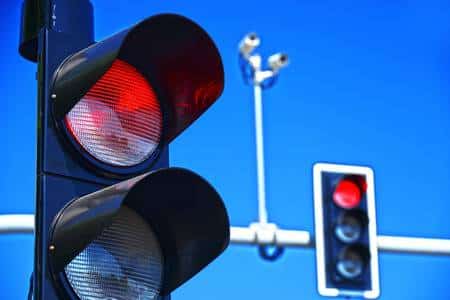Most of us learn the basics of traffic signals at a young age: green means go, yellow means slow down, and red means stop. Yet, despite these early lessons, hundreds of people are still killed every year in car accidents when motorists chose not to stop at red lights.
In 2017, the Insurance Institute of Highway Safety (I.I.H.S.) reported 890 fatalities and over 132,000 injuries resulting from red-light crashes. More than half of these deaths were bicyclists, pedestrians, and occupants of surrounding vehicles who were hit by red-light runners. In some busy intersections, motorists could be witnessed running a red-light every 20 minutes, especially during rush hour or peak travel times.
Fatalities and injuries caused by drivers who neglect to stop at red lights are 100 percent preventable. National Stop on Red Week, lead by the National Coalition for Safe Roads (N.C.S.R.), is a safety campaign observed in the first full week of August every year. This initiative aims to spread awareness on the deadly risks drivers pose to others when running red lights, and what communities can do to prevent these accidents from occurring in the future.
National Stop On Red Week
Stop on Red Week runs from August 4 to the August 10. Each day of the safety campaign is dedicated to educating drivers on the vital safety information they need to help reduce unnecessary red-light crashes. Here is how the week is broken down:
Types of Red-Light Runners
There is more than one way to run a red-light at a traffic stop. The I.I.H.S. reports drivers are considered to have run a red-light if they do any of the following:
Drivers who enter an intersection to turn left, and are stuck after the light turns red, are not considered red-light runners. However, these motorists are putting themselves at a heightened risk for accidents by drivers who may run red lights in the process.
Drivers Who Most Often Run Red Lights
The AAA performed a telephone survey in 2017 that found disturbing trends surrounding drivers who run red lights. The survey showed at least 93 percent of drivers believed it was unacceptable to run a red-light. Unfortunately, at least 43 percent of these drivers also admitted to running at least one red-light in the last 30 days. It should also be noted that these statistics only include the drivers who admitted the reckless behavior; many other drivers keep it a secret when they break the law.
Although all drivers are capable of running a red-light, the I.I.H.S. reports these groups were more likely to go through with it:
How To Get Involved
New Yorkers can be extremely influential in their communities when it comes to reducing the number of red-light accidents. The more you advocate for the safety of your neighborhood, the more likely you will be to witness change. These are just a few ways residents can get involved:
Ask For Red-Light Cameras
Residents can show their concerns for red-light accidents by participating in local government meetings to advocate for the installation of red-light cameras in their communities. Several residents are against red-light cameras in fear of acquiring hefty fines for minimal traffic violations. However, following up your position by educating your neighbors and friends on the benefits of these systems can help ease push back.
Look Into Extended Yellow-Light Signals
Studies have shown shorter yellow light signals lead to more red light runners. Inquiring with your city or town officials about extending the length of yellow lights could help reduce the number of accidents caused by drivers attempting to beat a short signal.
Social Media Presence
Social media is another excellent way to spread statistics and awareness of the prevalence of red-light accidents. Advocates can show their support by copying the statistics and images provided by the N.C.S.R. and using hashtags such as #StopOnRed2019 and #StayAlertStayAlive to spread the word and get others on board with your mission. Profile banners are also available to show your support of this worthy cause.
For more tools and resources on how you can participate in Stop on Red Week, visit the N.C.S.R.’s website here to view the full campaign.
New York City and Long Island Accident Attorneys
Our personal injury attorneys at the law firm of Siler & Ingber, have over 20 years of experience serving clients across New York City and Long Island. We protect your rights by maximizing recovery and securing the financial support our clients need to succeed on their road to recovery. Our winning attorneys know how to navigate through the claim process using past experience as insurance defense attorneys. We are not afraid to fight and are fully prepared to take your case to trial to get a justified verdict over settling for less.
If you or a loved one has been injured in an accident due to the negligence of another, our team at Siler & Ingber are here to help. With a 98% success rate, we have the experience and the know-how to help our clients achieve a favorable outcome. Contact us today at 1-877-LAW-4343, or schedule an appointment online anytime. We never charge a fee unless we recover money for you.

The Impact Of Marijuana Legalization
Would New York legalizing recreational marijuana increase road accidents? We took a look at the stats in our latest study.
View StudyThe Law Office of Siler & Ingber, LLP
Phone:
1.516.294.2666
Address:
301 Mineola Blvd. Mineola, NY 11501
Subscribe to our Newsletter
SubscribeThis is a unique website which will require a more modern browser to work!
Please upgrade today!

